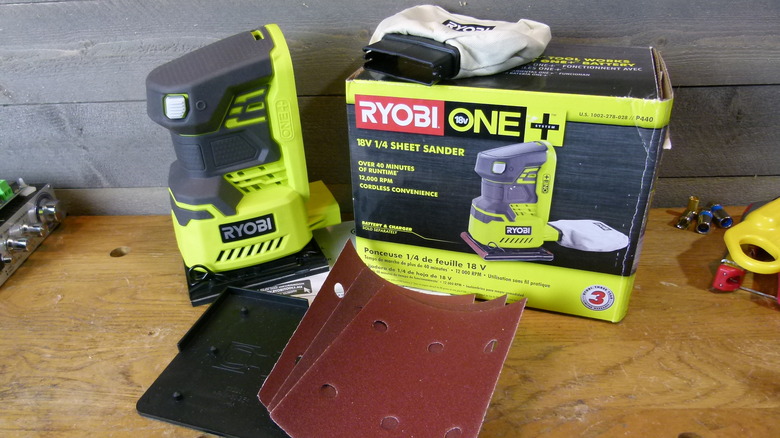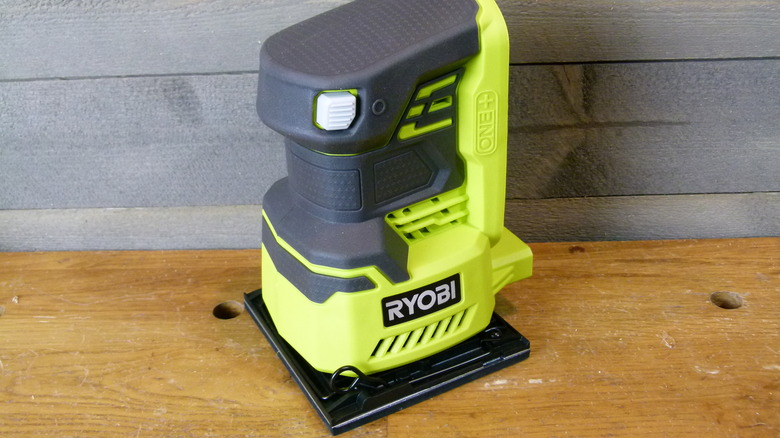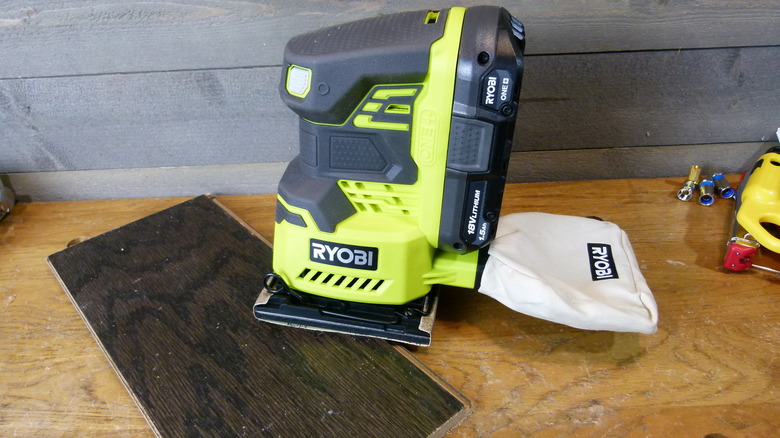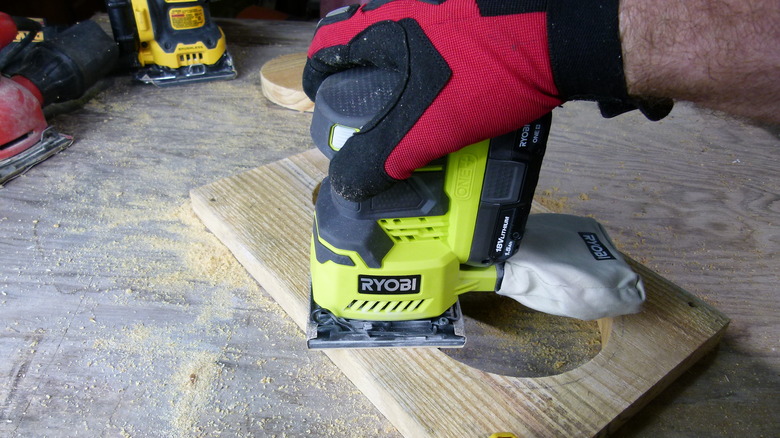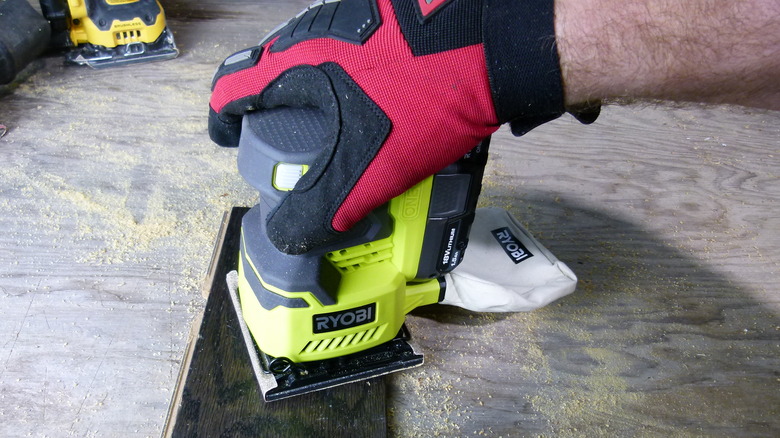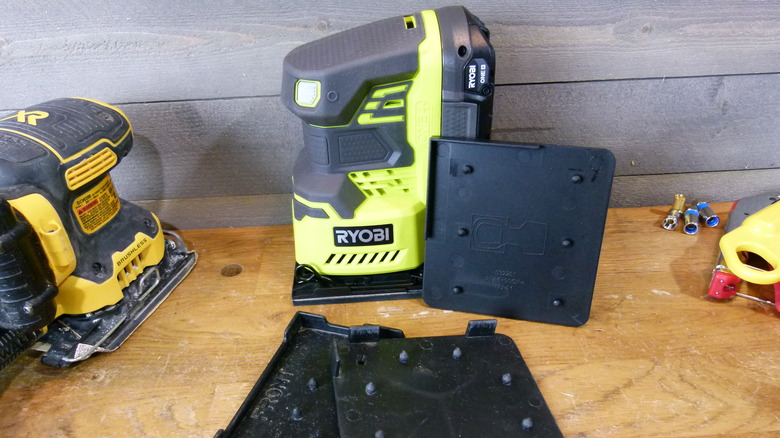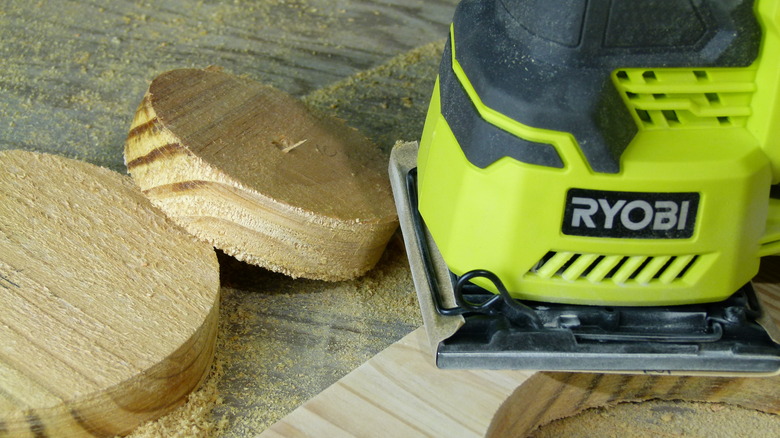We Tried The Cheapest Mini Sander At Home Depot. Here's How It Went
Everyone who buys a sander hopes desperately that they'll love it, but knows down deep that it's more of an unfortunate necessity than an opportunity for carpentry joy. Why? Standing is, alas, the most tedious aspect of woodworking. And so it is with the Ryobi P440 One+ quarter-sheet palm sander, which managed to exceed our expectations while still being slightly disappointing.
The purchasing experience was off-kilter from the start. We were in search of Ryobi's Corner Cat, a wittily-named mouse sander which was supposed to be in stock at Home Depot and wasn't. Some half-hearted scanning of the overstock ensued following a proactively apologetic look from the employee, who knew where this was going.
This made the P440 the cheapest cordless quarter-sheet sander in our local Home Depot at $49.97. Judging by the display model, it's not the sort of thing you'd look at and instinctively say "this is it, this is the tool for me." You can identify most tools at a glance by their shapes (like dog breeds or cars) before everything starts looking like an Altima. But this tool, without a battery, resembles nothing so much as a pot-bellied little robot with a mild scowl and an unfortunate need for a bag attachment. Before you notice the sanding pad at the bottom, you think maybe it's some sort of beefed-up trim router — not a palm sander with its bulbous top, nor a half-sheet sander with two hand-holds and the boxy-but-streamlined look of an '80s K-car converted to a hobbyist dragster.
The Ryobi One+ P440 at a glance
But, of course, it is a sander, and an inexpensive one at that ($44.97 on the Ryobi site, less than at Home Depot). So we took it with us and gave it a good, hard look before getting to the business of testing. The current contrarian wisdom is that "of course you judge a book by its cover, that's what a cover is for," so we immediately deemed this a tale about instability and awkwardness. The P440 is too tall to do much but tip over, and with a battery installed is too bulky to be a palm sander for anyone who hasn't occupied an NBA roster at some point.
The P440 is part of Ryobi's One+ battery platform. This particular offering didn't come with a battery or charger, but it is available as part of various kits that include other tools, batteries, and/or battery chargers. Its on/off switch locks into the "on" position (and the "off" position as well, thank goodness). Ryobi makes rather too much of this feature because, as you might expect for a very affordable tool, it lacks advanced features like speed control and soft start — so you're locked in at 12,000 orbits per minute (OPM) from the start.
The sander comes with a small dust collection bag, a hole punch for making quarter-sheets of sandpaper match its dust ports, a three-sheet "sandpaper assortment," and a manual that's overkill for a device with nothing but an on/off switch.
How we tested the sander
It is difficult to quantify the experience of using a sander. Outside of a lab, how do you objectively describe how smooth a workpiece got? Even weighing the material removed, or collected in a dust collection bag, is of little use without knowing exactly how much pressure was applied, for how long, and so on. So we put the P440 to work right away in some fairly real-world situations.
First, we attempted to remove the finish from a cutoff scrap of engineered hardwood flooring. We knew this was an unrealistic goal, but were curious how well its very small 1/16-inch orbit diameter would manage a task that can flummox far more aggressive sanders.
Next we used a soft pencil to mark some speaker cabinet faces made from rough-sawn pine and progressed through three grits of Gator and Diablo sandpaper (60, 100, and 150 grit), re-marking at each change, until the marks were gone and the surface seemed as smooth as it was likely to get. Because the P440 is available in kits with 2.0 Ah batteries, we used 2 and 1.5 Ah batteries. For each test, we used a DeWalt 20 Volt Max XR brushless quarter-sheet sander as a benchmark against which to compare the Ryobi. (We didn't expect the P440 to compete with the DeWalt, but thought the comparison useful.) We did not test the capacity of the P440 to sand plastics, a function mentioned in the operator's manual.
How it exceeded expectations
While at first it felt like grabbing a tiny robot toddler by the head to direct him away from various dangers, using the P440 turned out to be completely comfortable. It was stable and showed no inclination to upend itself, except when we plugged it in with the power switch locked on. (Without a soft start feature, you get the 12,000 OPM more or less instantly, which results in sudden chaos and potential damage to your workpiece. This is an operator error, and no fault of the sander.)
The engineered hardwood test went poorly, the only possible outcome. After five minutes with 100 grit sandpaper and little to show for it, we graduated to 60 grit and applied a little pressure. After another five minutes, most of the finish was removed from the wear layer in a 9-inch x 5-inch area, and we gave up. The Ryobi performed no worse or better than any other sander of this size would have, largely because engineered hardwood includes many coats of a hard protective finish of polyurethane, aluminum oxide, etc., per Cali Bamboo. Sanding this stuff is difficult because scratch resistance is its job, and it quickly gums up your sandpaper, rendering it nearly useless.
The speaker cabinets went more... smoothly. It took around 15 minutes to sand each cabinet face with three grits, and the DeWalt was only a few minutes faster. The Ryobi was not notably prone to scratch patterns, a hazard of quarter-sheet sanders.
How the Ryobi 440 could be improved
The DeWalt did do better with coarse sandpaper, probably because the 1/16-inch orbit diameter produces better results with finer paper, and this could be considered a weakness of the Ryobi P440. Sanders are not great at removing material quickly with such limited motion, according to Abrasive Boss. This might be the P440's major drawback: It was simply designed to be better at fine sanding work.
Nor, really, is battery life a flaw. One speaker front, about 15 minutes of sanding, was all we could squeeze out of a 1.5 Ah battery. This is not surprising. Sanding is much more demanding than other power tool uses, which tend to be intermittent rather than constant over long periods of use. Bigger batteries would be more appropriate for sanding.
Reviewers pointed out a few other issues that we didn't experience, often writing some variation of "I own many Ryobi One+ tools, and this is the first I've wanted to drown in holy water." Many found that the sandpaper didn't stay attached during use, which didn't happen to us. This could result from poorly installed sandpaper or a bent, weakened sandpaper clamp. The two springy wire clamps look like a chintzy way to attach sandpaper, but even the DeWalt (which costs more than three times as much as the Ryobi) uses one of these clamps, along with a second of a different design. These wire clamps appear to help them take up slack in the sandpaper.
Other problems with the Ryobi P440
Other flaws range from mildly annoying to outright trivial. For one, we noticed that after near-constant sanding, the P440's motor would become noticeably hot and begin to smell like an electric motor you don't want to rely on. But the sander never failed, so it's impossible to say if this is an actual problem. We also noticed that the batteries would get too hot to charge until they cooled down, but this is very common with any batteries used under heavy load for very long at all.
What was a problem is that this thing is ridiculously difficult to switch on and off — nearly impossible to do one-handed. One reviewer complained that the button placement caused him to inadvertently turn the sander off, but there's no way you can turn the P440 on or off accidentally. We figure you need to work out, maybe take a martial arts class, in preparation for turning it off.
The dust collection bag is tiny and yet, it turns out, over-sized. Sanding the pine produced a lot of sawdust, almost none of which entered the collection bag. If your solution is to attach a Shop Vac, you will need a $10 adapter for the oddball vacuum port. Oh, and there should be mounting holes pre-drilled in the sandpaper punch like there are in the DeWalt and Black & Decker versions we have — not because it's more convenient when mounted, but because otherwise we'd lose the thing.
The final, definitive, authoritative recommendation
So, would we recommend the Ryobi One+ P440 quarter-sheet sander based on all of this? No, probably not. The sander isn't bad — though the slight issue with coarse sanding is something to consider — but unless you're willing to invest in an extraordinary tool like the DeWalt 20V Max XR Brushless you're going to be better off with a corded sander. If you've already invested in the Ryobi One+ battery platform, and particularly in batteries in the 4 Ah range, the P440 might make a little more sense for you. With larger batteries the sander might be more aggressive, although this introduces some other problems like a propensity to roam.
As mentioned above, you can get the P440 in a kit with a battery and charger, but it's $139... far more than a very good corded sander — not to mention that having just one battery is a lot more frustrating than dealing with a cord. For the same price as this model without charger or battery, you can buy a 2 amp corded Ryobi sander that's basically the same device in a better form factor and with more power. Plus, it comes with a bag that you can pretend holds a cordless Ryobi sander. But you also can, and should, pony up $11.67 more and get the basic DeWalt corded quarter-sheet, 2.3 amp, 140000 OPM sander that is better all around. And its sandpaper punch has mounting holes.
